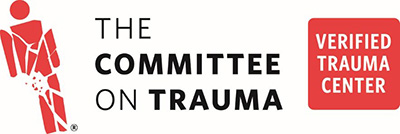Trauma Care
Lakeview Hospital , your only verified Level II Trauma Center in St. Tammany Parish, delivers the highest level of trauma care 24 hours a day, 365 days a year. When it comes to extreme life-threatening and critical injuries, Lakeview Regional is readily equipped with the latest technology and the most skilled caregivers.
 In 2021, Lakeview Hospital received its Level II Trauma Center verification
by the American College of Surgeons and designation from the Louisiana
Department of Health. This achievement recognizes outstanding teamwork,
commitment to quality resources, and excellence in advanced critical care.
In 2021, Lakeview Hospital received its Level II Trauma Center verification
by the American College of Surgeons and designation from the Louisiana
Department of Health. This achievement recognizes outstanding teamwork,
commitment to quality resources, and excellence in advanced critical care.
Did you know treatment at a trauma center improves survival rates by 18%? Lakeview Hospital is dedicated to providing the resources for trauma care, including a full spectrum of care required for all types of injuries, from the pre-hospital phase through rehabilitation. Our trauma team consists of trauma surgeons, neurosurgeons, orthopedic surgeons, anesthesiologists, and cardiothoracic surgeons.
What is a trauma center?
Lakeview Hospital is a hospital you can trust to deliver expert care for life-threatening injuries. We have been designated a Level II Trauma Center by the Louisiana Department of Health and Hospitals, making us the first and only hospital in St. Tammany Parish to achieve the distinguished classification. This is the highest ranking a non-university-affiliated emergency center can attain.
Our Level II trauma center status is a verification granted by the American College of Surgeons. We maintain our trauma center verification by providing round-the-clock coverage for all trauma emergencies, performing rigorous performance improvement and patient safety and offering trauma outreach education. It is important to note that all hospital emergency rooms are not equally prepared to care for internal injuries, head injuries, heart attacks, strokes and spinal cord injuries. Designated trauma center emergency departments must follow strict requirements for staffing, specialist availability, response times, training, quality improvement and community education. And most importantly, trauma centers must have a high level surgical care team available to respond to trauma 24 hours a day.
Types of trauma
Some examples of traumatic injuries are brain injuries, spinal cord issues, amputations, concussions, skull fractures, and cerebral contusions. Spinal Cord Injuries (SCI) often result in paralysis, bowel dysfunction, and sensory loss. Traumatic amputations involve the complete or partial loss of a body part including an arm, leg, toe, or finger. Other common trauma types include crush injuries, broken bones, severe burns, puncture wounds, hemorrhages, collapsed lungs, sensory hearing loss, and dislocated jaws.
Signs of trauma
There are a wide variety of signs and symptoms associated with traumatic injuries. The severity of these symptoms often depends on the extent of a patient's injuries. Signs can include pain with or without swelling, breathing issues, external or internal bleeding, amnesia, severe headaches, vomiting, loss of muscle strength, coma, bladder or bowel functioning problems, and visible deformities. Symptoms can also manifest in more underlying ways such as high fevers, metabolic rate increases, heart rate increases, and abnormal fluid accumulation.
